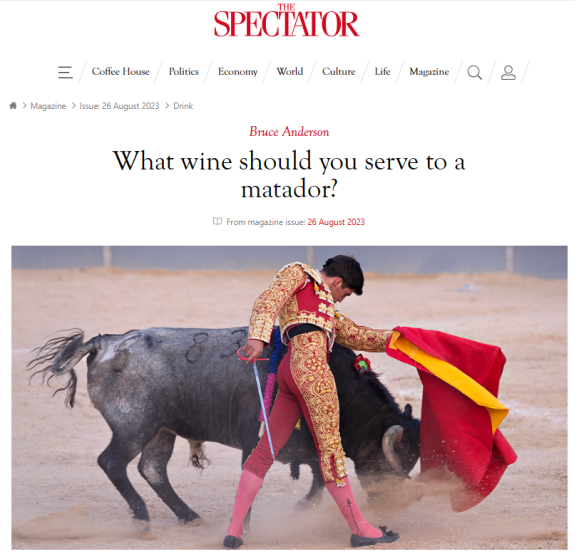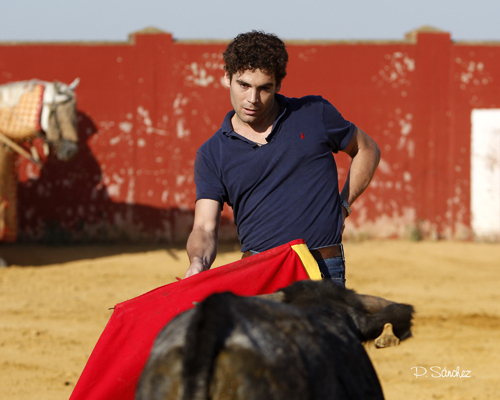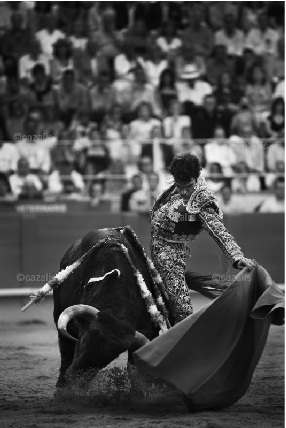
Alexander Fiske-Harrison, David Yarrow and the toro bravo Pañoleto at the finca Zahariche of the Spanish fighting bull breeders’ Miura © 2024 Richard Dunwoody – All Rights Reserved
When the legendary fine art photographer David Yarrow calls you answer. Not least when he says he wants to extend his photography of wild things to the animal that most closely resembles the undomesticated ancestor of all modern cattle (Bos taurus), the aurochs (Bos primigenius primigenius.)
David’s up close and personal shots of the beasts of the wilderness, reproduced on the internet ad infinitum, but in actuality produced as vast, wall-sized prints of the highest quality, hair-fine resolution, sell for tens – sometimes hundreds – of thousands of pounds, euros and dollars.

THE SNOWMAN by David Yarrow (2023)
Sometimes he includes supermodels in his more set-piece works.

CINDY’S SHOTGUN WEDDING by David Yarrow (2019)
The Spanish toro de lidia, aka toro bravo, ‘brave bull’, comes in the top ten genetically for relatedness to the ancestral aurochs, and six of the others in the top ten are its Spanish cousins (including the berrendas who feature later.) However, the toro bravo is the closest in phenotype – anatomy, morphology and behaviour – by far.

The Aurochs from Vig, whose skeleton is in the National Museum of Denmark, weighed almost 1000 kg (2,200 lbs), and its shoulder height was almost 2 metres (6 feet 6 inches.)

You can see the relatedness of the toro de ‘Lidia’ to a British fossil of aurochs, in this summary for Rewilding Europe of the paper ‘Genetic origin, admixture and population history of aurochs (Bos primigenius) and primitive European cattle‘, published in the journal Heredity in 2016.
Having received my brief, I knew exactly where to go: the one breeding ranch, founded in 1847, which famed for its cattle that most closely match the vast size of the aurochs of all the strains of toros bravos and whose extraordinary ‘feral’ (I mean that in the biologist’s sense of the word) aggression most matches the aurochs wild character. It is the name which conjures fear among matadors. As Ernest Hemingway put it in his 1932 classic, Death In The Afternoon:
There are certain strains of bulls in which the ability to learn rapidly in the ring is highly developed. These bulls must be fought and killed as rapidly as possible with the minimum of exposure by the man, for they learn more rapidly than the fight ordinarily progresses and become exaggeratedly difficult to work with and kill. Bulls of this sort are the old caste of fighting bulls raised by the sons of Don Eduardo Miura of Sevilla… which made them the curse of all bullfighters.
A study by the University of Complutense in Madrid, published as ‘Ancestral matrilineages and mitochondrial DNA diversity of the Lidia cattle breed‘ in the journal Animal Genetics in 2008 showed how among the toros bravos which all show “a certain degree of primitivism”, the Miuras are alone as a breed-within-a-breed.
On a less academic level, Miura is the reason why Ferruccio Lamborghini named his first car the Miura in 1967 – he showed it to old Eduardo Miura, father of the present owners, Eduardo and Antonio, and even drove it to their ranch to show them. Several more models from that marque took their name from Miura bulls afterwards: from the Islero in 1968 to the Murciélago in 2001.

Autumn 1968. Finca Zahariche in Lora del Río, Spain. Standing, in a black suit, Ferruccio Lamborghini, next to Eduardo Miura, patriarch of the famous family of fighting bull breeders. The year before, the legendary car began to be sold, the Lamborghini Miura, the first supercar in history.









 He must have come close to expulsion. But there was apparently a feeling that Fiske-Harrison would make his mark in the world. And those who argued in that vein might now feel vindicated, because Alexander became a matador.
He must have come close to expulsion. But there was apparently a feeling that Fiske-Harrison would make his mark in the world. And those who argued in that vein might now feel vindicated, because Alexander became a matador.











 I have just released a book, which I edited and co-authored, titled The Bulls Of Pamplona (purchase details and the July 7th post-bull-run Pamplona signing by its authors – 1pm outside Marceliano’s –
I have just released a book, which I edited and co-authored, titled The Bulls Of Pamplona (purchase details and the July 7th post-bull-run Pamplona signing by its authors – 1pm outside Marceliano’s – 


